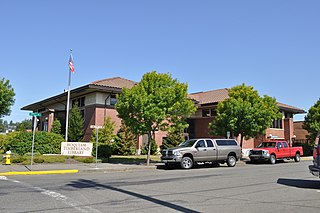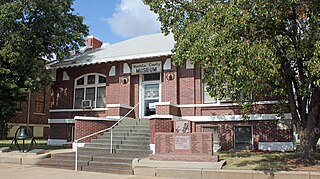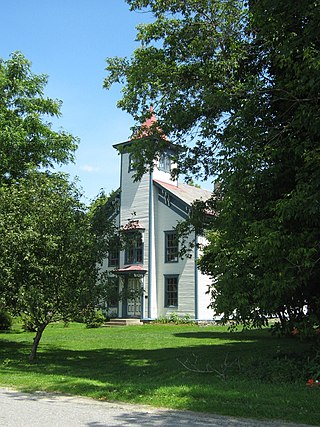
The Northwest Railway Museum (NRM) is a railroad museum in Snoqualmie, King County, Washington. It incorporates a heritage railway, historic depot, exhibit hall, library, and collection care center, and serves more than 130,000 visitors per year.

The Central Vermont Railway Depot is a historic former train station at Depot Square in the village of Northfield, Vermont. Built in 1852, it is believed to be the oldest surviving railroad station in the state. It was listed on the National Register of Historic Places in 1975.

The Dalles Carnegie Library is a historic former library building located in The Dalles, Oregon, United States. It is one of the thousands of libraries whose construction was funded by Andrew Carnegie. The construction grant of $10,000 was approved in March 1907, and it was dedicated in September 1910.

The Carnegie Free Library of Beaver Falls is a historic Carnegie library in the city of Beaver Falls, Pennsylvania, United States. Erected as Beaver County's first library building, it was financed by Andrew Carnegie and designed by a leading Pittsburgh architect in grand architectural style that helped to redefine the image of the typical Carnegie library. Numerous community organizations have used its space, which remains in continued use as a library, and it has been named a historic site.
Fewell School is a historic site located in Fewell, Oklahoma. Fewell, 10 miles east of Nashoba, Oklahoma, is a rural community in the Kiamichi Mountains of Pushmataha County, Oklahoma.

The Skene Memorial Library is located on Main Street in Fleischmanns, New York, United States. It is also used as the village hall. The frame building, combining elements of the Queen Anne and Shingle architectural styles, dates to the early 20th century. Its exterior incorporates aspects of local train station architecture.

The former Auburn Post Office building is located in the City of Auburn, 20 Auburn Avenue NE at First Street NE. This is one block north Main Street, the historic business and commercial center. The main entrance is the west face on Auburn Avenue.

The Rensselaer Carnegie Library in Rensselaer, Indiana is a building from 1905. It was listed on the National Register of Historic Places in 1994. The building no longer functions as a library; since 1992 it houses the Prairie Arts Council, a local performing arts organization.

The Wichita City Carnegie Library Building located at 220 S. Main Street in Wichita, Kansas, Sedgwick County, Kansas, United States, is a Carnegie library built in 1915. It was listed on the National Register of Historic Places in 1987. The two-story, limestone Beaux Arts building stands in the southwestern part of Wichita's central business district, directly south of the old City Hall. Its façade orientation is west. The building measures approximately one hundred and twenty-eight feet from north to south and eighty-three feet from east to west. After the completion of Wichita's Central Library in 1966, the Wichita City Carnegie Library Building served as city offices and the municipal court until the Wichita Omnisphere and Science Center established its tenancy in 1976, followed by changing tenants.

The Carnegie Library in Lawton, Oklahoma is a Carnegie library building from 1922. It was listed on the National Register of Historic Places in 1976.

The Carnegie Library is a historic building still in use as the Hoquiam Timberland Library in Hoquiam, Washington.

Bennington No. 4, also known as the Bennington School, is a one-room schoolhouse near Waterloo, Iowa. Built in 1911, it served four sections which provided as many as thirty or more students for first through eighth grades. Students in higher grades attended Waterloo East High School. The school served the predominantly German-American community until 1955 when it was closed. While it was open, the school also served as a community center. In 1958 the vacant building was sold to the local Sage family, whose members had attended and taught at the school. Restoration work took place through the 1990s.

The Christian Geister House is a historic residence in Algonquin, Illinois.

The Cordell Carnegie Public Library is a historic Carnegie library located at 105 E. First St. in New Cordell, Oklahoma. The library was built in 1911 through a $10,000 grant from the Carnegie foundation; New Cordell's Commercial Club, which had opened a reading room the previous year, solicited the grant. Architect A. A. Crowell designed the library in the Mission Revival style; several of its elements reflect the emerging Spanish Colonial Revival style. The building's curved parapet walls, exposed rafters, and original red tile roof are all characteristic Mission Revival elements; its segmental arches, sunburst moldings, and ornamental ironwork resemble Spanish Colonial Revival work. The library was the only one in Washita County until the 1960s; it also served as a community center and was regularly used by local schools. In 1982, a new library opened in New Cordell, and the Carnegie Library building became the Washita County Historical Museum.

Lowell Commercial Historic District is a national historic district located at Lowell, Lake County, Indiana. The district encompasses 28 contributing buildings, 1 contributing site, and 1 contributing object in the central business district of Lowell. It developed between about 1870 and 1952, and includes notable example of Italianate, Queen Anne, Romanesque Revival, Bungalow / American Craftsman, and Art Deco style architecture. Notable buildings include the Roberts Building (1948), Colfax Lodge (1898), Bacon House, Lowell National Bank (1903), Lowell Town Hall (1922), and Lowell Carnegie Library (1920).

The Goodwillie–Allen House is a small American Craftsman-style bungalow located in Bend, Oregon. The house was constructed in 1904 by Arthur Goodwillie, the first mayor of Bend. Today, the building is owned by the City of Bend. It is the oldest structure inside the city limits of Bend, the oldest American craftsman style house in Deschutes County, Oregon, and the second oldest craftsman-style bungalow in Oregon. The Goodwillie–Allen House was added to the National Register of Historic Places in 2007.

Woodbine Public Library, also known as Carnegie Public Library, is located in Woodbine, Iowa, United States. The library was organized in 1907, and it was initially housed in the jail section of city hall. If there was inmate in the jail the public had no access to the library. The city council appointed a board of trustees in 1908 and they applied to the Andrew Carnegie for a grant to build a library building. They received a grant on April 28, 1909, for $7,500. The Eisentraut Company, a Sioux City architectural firm designed the Prairie School building. F. X. White of Eldora, Iowa was the contractor. The building was completed in February 1909, and it was dedicated on March 9 of the same year. This was the first library built in Harrison County.

The Jonesville Academy is a historic school building at Cochran and Duxbury Roads in Richmond, Vermont. Built about 1868, it is a prominent local example of Italianate school architecture, and was used as a school until 1955. It is now in private ownership as a residence. It was listed on the National Register of Historic Places in 1982.

The Goldendale Free Public Library in Goldendale, Washington is a historic Carnegie library which is listed on the U.S. National Register of Historic Places.

The Armstrong Memorial Building is a historic municipal building at 3 North Lowell Road in Windham, New Hampshire. Built in 1899, it was the town's first purpose-built library building, a role it played until 1997. It now houses the town museum. The building was listed on the National Register of Historic Places in 2018.




















